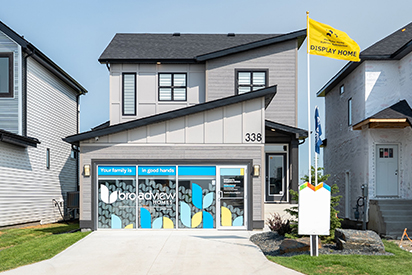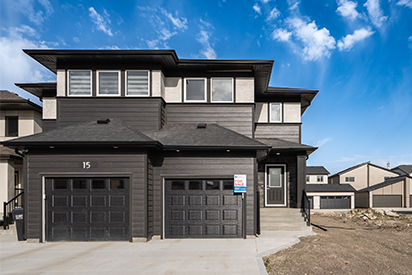Creative and Simple Ways to Save for a Down Payment

Saving for a down payment on your first home is an exciting task, but can also be a daunting one. In Canada, the minimum down payment you need for a home is 5%, however to avoid the CMHC fee, which is a default insurance, you’ll actually need a down payment of 20%. Whether you’re looking to save the minimum amount or strive for a 20% down payment, we’ve put together a list of 10 creative and simple ways that you can start putting money away and you’ll be in your first home before you know it!
Set a Budget
The first, and possibly most important aspect of saving money for your down payment, is to set yourself a budget. You may be a little shocked looking back on your spending habits and seeing how much money was put towards items that you really didn’t need.
Take some time to figure out your monthly expenses, separating between fixed and variable expenses. Fixed expenses are categorized as expenses that are the same month-to-month, such as your rent, cell phone bill or car payment, while variable expenses change over time, such as deciding to go to a movie with your friends or buying coffee before work. Write down all of your fixed expenses and do a quick calculation on how much of your pay cheque is required to cover those. Then you can decide how much you’d like to put aside for your spending money for the month (your variable expenses), and how much should go into your savings account. A good tip is to set up an automatic transfer between your accounts. This way as soon as you get paid, the amount you allotted for savings will automatically be transferred over and out of your chequing account. Once your money is in your savings, don’t touch it! Pretend that account doesn’t exist and make sure you’re not overspending with what you have left over.
Set a Time Frame

It’s always good to have a goal in mind, and while your end goal will be to save X amount of money for your down payment, knowing when you want to achieve it can be that extra little push you need to stay on track. Get yourself a calendar and choose the date you have in mind, whether it’s one year from now or three, and write it down. You can even set yourself milestones in-between to help stay motivated. There’s nothing more satisfying than crossing a goal off of your list, even if it’s the steps between accomplishing your final goal!
Pay Off Your Current Debts
When you go into your appointment with your mortgage specialist, one of their steps in the process of determining how much you can afford for a mortgage is to run a credit check. This looks into how much debt you currently have and what your habits are when it comes to paying your bills, which come together to determine your credit score. While you may think that having a loan or a credit card is a bad idea, they are important factors to prove that you’re responsible and pay your bills on time. On the flip side, if you miss any payments, they will negatively affect your credit score. Any current loans you have will also reduce your ability to borrow money as you already have borrowed money to your name. Make it your goal to pay off your current debt before trying to get approved for a mortgage.
Take the Time to Find the Best Deals

We know how easy it is to get an idea of a purchase we want to make and immediately go to the closest store to buy it. Before you jump in the car, take a bit of time to do some research. Many stores sell the same product and you may be able to find a better deal somewhere else. No matter if you’re saving $10 or $100, any extra money you can put into your savings account will make a difference when it comes to buying your first home.
Cancel Cable
We know this may be a hard one to get on board with and letting go of cable isn’t an easy task. However, with all of the streaming apps available you may be able to cut your spending significantly when it comes to television. The average Canadian household spends over $200 per month on a cable package, while streaming services such as Netflix and Disney Plus cost around $10-15 per month. You can make the switch from cable to a streaming service, or if you’re not ready to pull the plug, consider cutting down on the channels that you subscribe to.
Sell Unused Items

Get two tasks done at once! Before you move you’re going to need to go through all of your belongings and decide what’s going to come with you to the new house and what isn’t. Get a head start and make some money while you’re at it by selling some of the items that you may not have use for, but think someone else might. Facebook Marketplace is a great option for selling your items and you may be surprised at the amount you’re able to make on stuff you no longer need.
Implement a 2-Week Rule
If you struggle with impulse buying (or over-shopping in general) this could be a good hack for you to implement into your shopping routine. It’s not hard to see something you really like on the rack and immediately throw it into your cart, or find something online and not think twice before entering your credit card information. Unless it’s a really good deal that you just can’t pass up, we challenge you to leave it behind. If you can, wait two weeks (or at least a couple of days). At the end of the two week period, if you’re still thinking about the item, go get it. This will help you decrease the amount of money you spend on items that weren’t that important to you in the first place, and hopefully save you that extra bit of cash every time.
Ditch the Daily Coffee Run

It’s easy to fall into the habit of stopping at your favorite coffee shop on your way to work every day, but take a moment to consider how much you’re actually spending each month just on a cup of coffee. For example, let’s say you’re buying a regular coffee every morning before work, so around 5 times per week. A regular cup of coffee typically costs around $2, which would end up being $40 every month. Over a one year period, that’s $520! Not to mention if you’re purchasing specialty coffee which can run you upwards of $5 every time. Now we’re not saying to ditch the coffee all together, but making it at home beforehand could save you a good chunk of money. If you find that you really miss having your specialty coffee, treat yourself every once in a while, just avoid making it a daily habit.
Save Any Extra Money
So it’s the end of the month and you have done a really good job at watching what you’ve spent your money on, and now you have some left over. Instead of rewarding yourself by going on a little shopping spree, give yourself the recognition of how well you did, and then put that extra money into your savings account. Every extra bit will bring you closer to reaching your goal!
Try a Spending Freeze
A spending freeze is a great way to jump-start your savings and with the proper planning, it’s fairly easy to accomplish! Our recommendation is to start off with a 2-week spending freeze, and if you decide you like it and want to challenge yourself, increase the duration every time you do it. While there will be some spending required on necessities, such as gas and rent, the goal is to eliminate any unnecessary purchasers during this time. Before you start, plan your meals for the next two weeks (or however long you plan to do the spending freeze), and do a grocery shop beforehand to pick up what you need. You may also want to put a bit of money aside to pick up some fresh produce at the halfway point. For the next two weeks, don’t spend on anything apart from your regular bills and to fill your tank up with gas. It can be very eye-opening to see where you were spending your money previously and what you can cut back on going forward.
Buying your first home is an exciting time and it shouldn’t be dampened by the thought of saving for your down payment. By implementing some of these tips and starting early, we’re sure you’ll have your down payment before you know it, and can start the process of purchasing your first home!





















